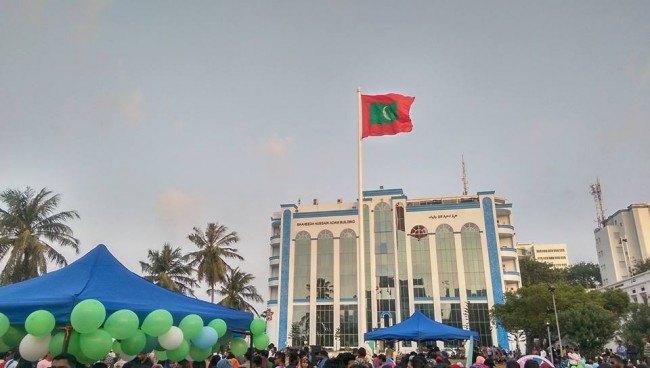
If any city were ripe to be a test bed for next-generation technology and urban planning, it would be one in a remote island country with few resources. Malé, the capital of the Maldives, is a perfect example.
The city is only 2.4 square miles (5.8 square kilometers), yet Malé is packed with over 100,000 people. Traipsing through the city reveals a vibe similar to Delhi or Mumbai instead of the other 1,200-odd islands that make up this tiny country of only 115 square miles.
At at time when many island states are among the most vocal countries when it comes to addressing the risks of climate change, one would think that Malé would be a leader on sustainable development. And in many ways, the Maldives itself is an economic development success story — at least according to the World Bank, which categorizes the country as having an upper-income economy. In 1980, the Maldives was one of the world’s 20 poorest nations, but the country’s GDP has expanded exponentially in the past 30 years.
The city is certainly compact, with its population density ranking among the highest on Earth. Malé, however, has become an environmental nightmare. The Maldives’ impressive economic growth has meant its people can afford more and better goods and services, as evident in the scooters and motorbikes that have taken over the island. Walking around the city is hardly a pleasure — it can actually be dangerous, due to the fact that sidewalks are nonexistent and the onslaught of motorbikes will inevitably make you want to just hide in your hotel. Even sauntering along the waterfront is fraught with risk thanks to irregular sidewalks and traffic congestion — there is no easy path to enjoy the teal- and cyan-colored waters that help make the Maldives an appealing place to visit in the first place.
One estimate suggests 1 in 6 residents in Malé own a motorbike, so do not expect any type of restriction to occur anytime soon. Considering the love Maldivians have for their scooters and motorbikes, the odds are higher that the country’s ban on dogs would be lifted first. “My daily runs around the island at night are hardly a pleasure,” said one Big 4 consultant I met who offered me a walking tour of Malé.
Although the United Nations and global governments have done their share to ensure Malé and the rest of the Maldives balance economic growth and sustainability, more work needs to be done. The quality of life could improve rapidly if a simple light rail was installed to travel the length of the island, which would improve traffic for the taxis and delivery vehicles that are needed to keep people and goods moving.
The Maldives’ government says it has a plan in place, which includes planned clean-energy installations, the development of an “integrated public passenger transport” and improvements in public health, but little evidence is on display in Malé. Public transportation is limited to ferries that haul people and products to outlying islands, including the one that is home to the country’s international airport. Recent efforts to improve the city have gravitated toward technology, as in Qatar-based Ooredoo’s commitment to offer Malé’s citizens free Wi-Fi. Those Wi-Fi spots, however, are few and far between.
One reason why sustainable development has lagged in Malé is because the Maldives has long been running huge budget deficits. While growth in the tourism sector has fueled the country’s economy, youth unemployment is still high, and true economic diversification has a long road head. The country continues to make strides in education, and there is a hunger for its youth to have careers not related to fishing, agriculture or tourism. Malé would be a great laboratory for investment in technologies and design strategies related to smart cities, but the evidence suggests that won't happen for a long time.
The result is a lost opportunity — guests who travel to the Maldives often have to spend at least one night in Malé before or after they visit one of the nation’s many resorts. Most of the country’s cultural treasures are here, and the city’s public spaces -- including a public beach with stellar views -- offer a quiet respite from the hectic city. And the city can be a convivial place to spend a day or two: Restaurants and cafes serving “short eats” offer delights for foodies; the waterfront presents impressive views; and the city’s largest open space, Sultan Park, is a great place to hang out day or night.
Malé could become a magnet for leaders and citizens worldwide who want to seek ideas on how to plan for long-term resilience in an era of diminishing resources. Unfortunately, short-term thinking is dogma in what would otherwise be a fantastic and educational place to visit, whether for research or even on the way to one of the Maldives’ famous posh resorts.
Image credits: Leon Kaye

Leon Kaye has written for 3p since 2010 and become executive editor in 2018. His previous work includes writing for the Guardian as well as other online and print publications. In addition, he's worked in sales executive roles within technology and financial research companies, as well as for a public relations firm, for which he consulted with one of the globe’s leading sustainability initiatives. Currently living in Central California, he’s traveled to 70-plus countries and has lived and worked in South Korea, the United Arab Emirates and Uruguay.
Leon’s an alum of Fresno State, the University of Maryland, Baltimore County and the University of Southern California's Marshall Business School. He enjoys traveling abroad as well as exploring California’s Central Coast and the Sierra Nevadas.














